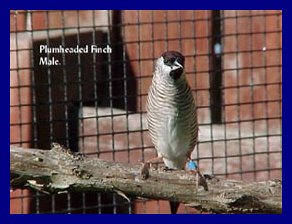"Australian Aviculture"
, the official publication of The Avicultural society of Australia.
Also Published in the May/June & Sep/Oct issues of
The National Finch and Softbill Society. A bi-monthly publication in the U.S.A.
Plumhead Finches. ( Aidemosyne Modesta )
Introduction.
These charming little Australian natives are also called Cherry finches and similar names in many parts of the world, all names refer to the deep, blood plum, red on their head . Five or so years ago I read somewhere (AA I think), that these finches were in decline in Australian aviaries and needed serious breeding efforts to make its future secure. I read all I could find about them and decided to give them a go, if I could find them. Although I am certainly no expert, I was quietly confident I could breed this finch.
Description.
See photo for visual description.
Sexing.
Sexing adult Plumheads is easy, males have a telltale bib under their beak and generally more defined stripes on their body and a little more crimson on their head. The females also have a white eye stripe. As soon as they start to acquire their adult plumage the young males will start to gain the brown bib, this is usually within around six weeks after fledging and is quicker in summer months.
Housing.
My birds are housed in a large planted aviary (Approx. 6m x 4m) of which about 1\3 is sheltered. The back wall blocks the cold winter winds from the south. The open flight has a wire roof which has a strip of galvanised roofing on the east wall to accommodate dry brush nesting . All perches are made from natural branches and vines. Three pairs of Plumheads share this aviary with four pairs of Diamond Firetails, two pairs of Gouldian Finches and one pair of the following, Painted Finches, Red faced parrot Finches, and Cuban Finches. All of these birds breed well together and although Plumheads are at the bottom of the pecking order, they regularly fledge nests of 3-5 young. There are Nesting boxes, wicker baskets and dry, prickly, paper bark brush both under the shelter and in the sheltered section of the flight.
Feeding
All my birds are fed Finch breeder mix with separate canary and red millet and niger, cuttlefish bone is placed in 3 or 4 positions around the cage and grit is always available, I make a mix up equal parts cuttlefish, charcoal and coonara shells in a 20lt white bucket, then I crush it with a pick handle and sieve it.
I collect grass seeds daily from several locations, I try to pick as wide a variety as possible, excluding papsulam grass, which can be poisonous, it mainly seeds in summer and is identifiable by its black sticky seeds on metre long stems. Plumheads love all grass seeds especially native varieties, whether feeding young or not. All of my birds love salt bush (Rhagodia spinesens) and I feed it at least weekly. John Buchan our clubs president gave an address to the Avicultural society a few years ago in which he mentioned the benefits of dandelion seed, I transplanted some large clumps into the flights and soon the parrot finches learnt to open the seed heads, by tearing the side away when they are about to open. Not long after the Plumheads also learnt this, they relish these seeds. I haven't seen any other species use this method, although they all eat the ones I pick and open. Palm grass grows in the flight and Plumheads are always seen feeding on this. Each day I feed either Silver beet, spinach, broccoli or other greens and all are taken by Plumheads. Fresh corn on the cob is fed daily, although Plumheads rarely partake of this. Bush fly maggots are fed daily and Plumheads eat a little of these only when feeding young . I only feed soaked seed if the weather is so bad that I can't get out and get grass-seed. No commercial vitamin\mineral supplements are fed, as I prefer to feed them naturally.
Water.
Clean bathing water is essential for all finches and Plumheads are no exception, my 3 pairs and any young they have, come down in a flock and bath together at least once a day, all year round. Fledglings have frequently been sighted bathing first day out of the nest. I have installed an automatic overflow system it can be programmed to come on more often in summer, or for longer periods. We manually tip it out at least twice daily, then just push "water all stations" . The run-off waters the garden. All water dishes are on bricks or rocks away from food, nearby I have placed upright standing rocks for the birds to use as intermediate perches when coming in to drink\bath. This keeps their nails trim and feet pads healthy. All dishes have a flat stone in them so fledglings can get out if in trouble.
Courtship
Plumhead males dance a bit with grass in their beak but their most notable courtship trait is, the males stand dancing on a branch with grass in beak and flies across to the furthest perch snapping his wings together. This action makes a loud clicking sound. All the finch species I have go through their courtship routines and usually get "knocked back" after it, but every single time I have noticed the Plumheads doing their wing-clicking flight they get "lucky". Plumhead fledglings in my aviary have been sighted displaying only 23 days after fledging.
